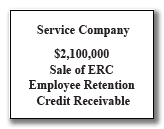|
ERC Challenge:
 A $40 million West Coast based service company got hammered by COVID-19. Most of the Company’s customers were shut down during the height of the Pandemic. The Company reported a loss from operations in 2019, but implemented a turnaround plan in early 2000 to bring the Company back to profitability. The Pandemic killed the Company’s ability to right the ship and the Company reported an even larger loss in 2020. Unfortunately, the lingering effects of the Pandemic continued to adversely affect the Company and the loss reported in 2021 was four times as large as the loss in 2020. The Company’s payables were mostly past due and the Company was forced to take on expensive short-term debt in 2021 in order to survive. A $40 million West Coast based service company got hammered by COVID-19. Most of the Company’s customers were shut down during the height of the Pandemic. The Company reported a loss from operations in 2019, but implemented a turnaround plan in early 2000 to bring the Company back to profitability. The Pandemic killed the Company’s ability to right the ship and the Company reported an even larger loss in 2020. Unfortunately, the lingering effects of the Pandemic continued to adversely affect the Company and the loss reported in 2021 was four times as large as the loss in 2020. The Company’s payables were mostly past due and the Company was forced to take on expensive short-term debt in 2021 in order to survive.
The Company was fortunate to have received 2 PPP loans which helped the Company make it through 2020 and 2021. However, the Company quickly depleted these PPP funds and was then forced to sell off one of its divisions to raise cash to offset its 3 years of consecutive operating losses.
The one asset the Company had on its books that could be converted into cash was the Employee Retention Credit Receivable (“ERC”). The Company filed its 941x’s for the 1st, 2nd and 3rd quarters of 2021 in July 2022. The Company learned that it was taking the IRS approximately 12 months to send out ERC refund checks and that the wait could even be longer for ERC claims over $1 million. The Company was in desperate need of additional working capital and learned that Asset Enhancement Solutions, LLC (“AES”) was helping companies monetize their ERC receivable.
ERC Solution:
Asset Enhancement Solutions, LLC (“AES”) performed an assessment of the Company and learned that the Company’s existing senior and junior debt were secured by all of the assets of the Company and that refinancing these credit facilities would probably not result in additional liquidity for the Company. The Company’s existing lenders were not willing to lend funds against the ERC receivable as they did not understand this asset and deemed it to be too risky.
Thus, the only asset that could potentially provide the Company with some liquidity was the Company’s ERC receivable. AES provided the Company with a few options for monetizing its ERC receivable. These options ranged from borrowing against this receivable to selling the receivable to a fund that was purchasing ERC claims at a discount.
The Company decided to sell its ERC as it was able to maximize the amount of funds it received at the closing of the transaction. The ERC Buyer as able to close the transaction in approximately 30 days. The proceeds the Company received from selling its ERC provided the Company with the funds that were urgently needed to keep the Company operating.
Contact
Neil Seiden, 516-767-0100
neil.seiden@assetenhancement.com
<< Back to index
| 
